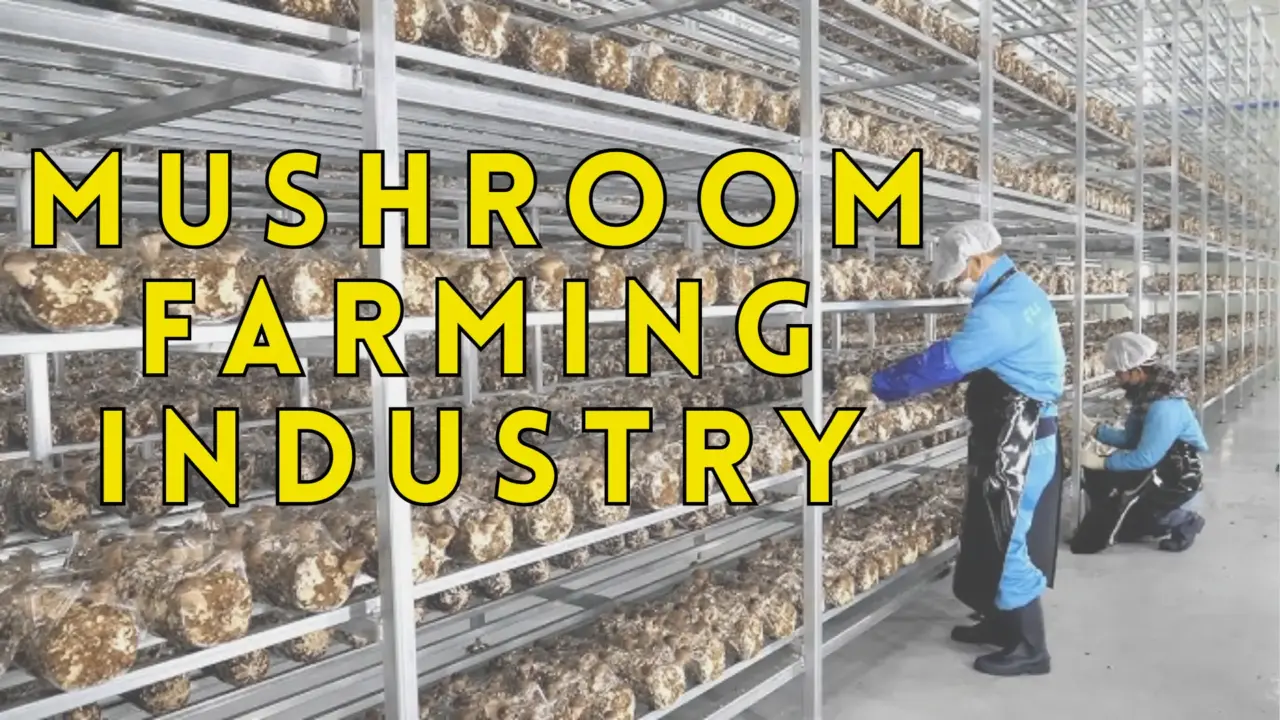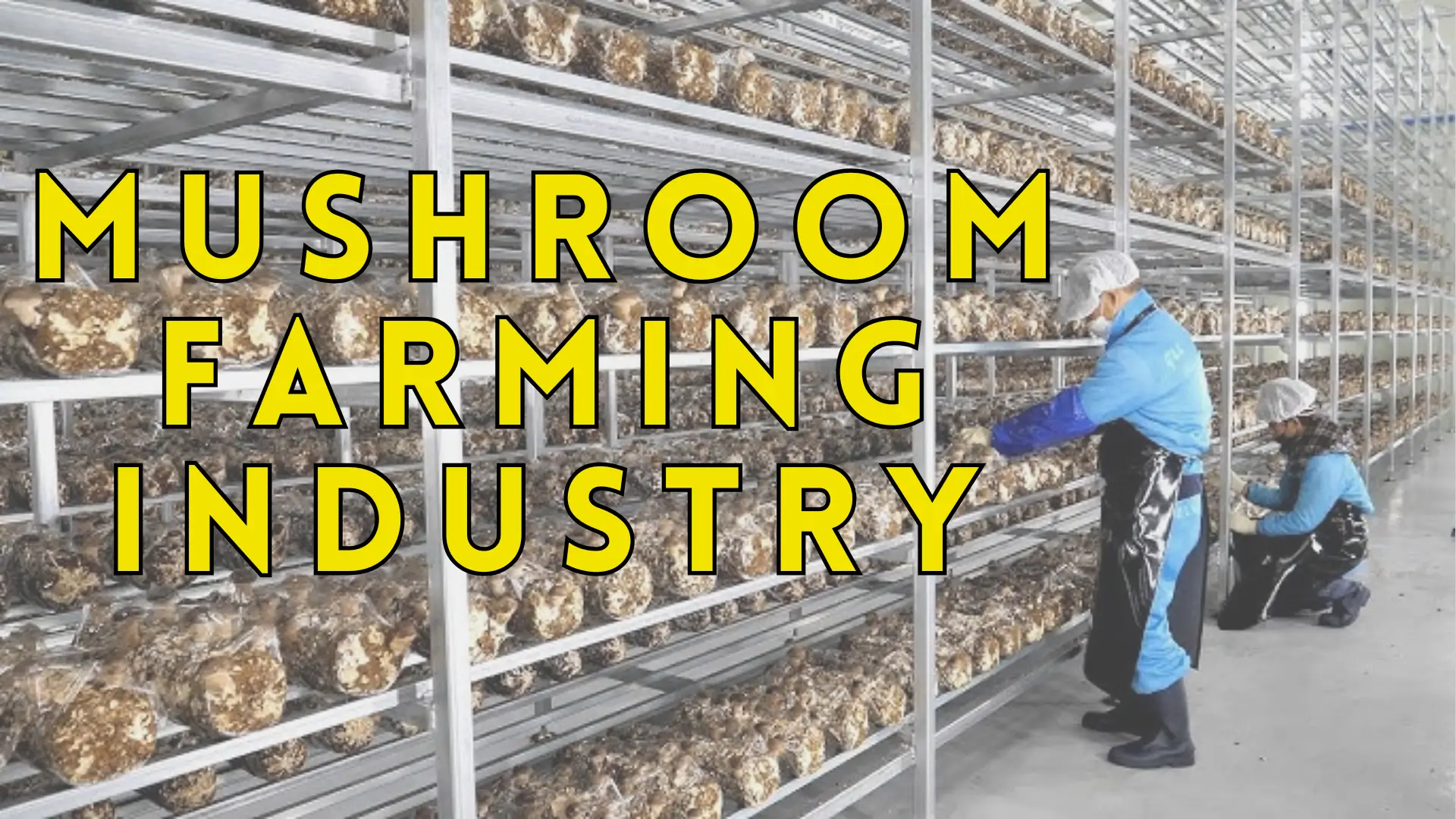The global mushroom farming industry has experienced remarkable growth over the past decade, driven by rising health consciousness, increasing demand for plant-based proteins, and innovations in agricultural technology. Valued at USD 71.81 billion in 2024, the market is projected to reach USD 119.76 billion by 2033, growing at a 5.8% CAGR. In India, states like Uttar Pradesh, Bihar, and Odisha lead production, with small-scale farmers reporting annual profits of up to ₹1.9 lakh from just 500 sq. ft. of cultivation space. This article provides an in-depth analysis of mushroom farming, covering cultivation techniques, financial planning, market trends, and future opportunities.
Mushroom farming stands out as a low-investment, high-return venture requiring minimal land. Unlike traditional crops, mushrooms thrive in controlled environments and convert agricultural waste into nutritious food. With 73% of India’s production focused on button mushrooms and growing export demand for exotic varieties like Shiitake and Oyster, this sector offers diverse revenue streams. Below, we explore every facet of starting and scaling a successful mushroom business.
Mushroom Farming Industry

| Global Market Size | USD 71.81 billion (2024) → Projected USD 119.76 billion by 2033 |
| Key Producing Regions | Asia (82.8%), Europe (12%), Americas (4.5%) |
| Top Indian States | Uttar Pradesh, Bihar, Odisha, Maharashtra, Haryana |
| Profit Margin | ₹50,000–₹1,00,000/1,000 bags annually; up to ₹5 lakh/500 sq. ft. |
| Popular Varieties | Button (73%), Oyster (16%), Paddy Straw (7%), Shiitake (4%) |
| Growth Drivers | Vegan diets, functional foods, pharmaceutical applications |
Types of Mushrooms and Their Profitability
1. Button Mushrooms
- Market Share: 73% of India’s production
- Cost: ₹100–120/kg to cultivate; sells at ₹140–300/kg
- Yield: 7–8 kg/sq. ft. annually
2. Oyster Mushrooms
- Premium Pricing: ₹200–400/kg due to high protein content
- Climate: Thrives at 15–30°C with 80–90% humidity
3. Shiitake Mushrooms
- Export Demand: Popular in European and North American markets
- Cultivation: Requires hardwood logs or sterilized sawdust
Step-by-Step Cultivation Process
1. Substrate Preparation
- Materials: Wheat straw, gypsum, urea, and poultry manure
- Process:
- Chop straw into 8–20 cm pieces
- Mix with nitrogen-rich additives and sterilize at 65°C for 6–8 hours
2. Spawning
- Spawn Rate: 2–3% of substrate weight
- Methods: Surface scattering or mixing with compost
3. Casing
- Soil Mix: Sterilized garden soil + decomposed cow dung (pH 7.5–7.8)
- Layer Thickness: 3–4 cm to retain moisture
4. Fruiting and Harvesting
- Conditions: 15–25°C temperature, 85–90% humidity
- Yield: First harvest in 30–40 days; 3–4 flushes per cycle
Investment and Cost Analysis
Initial Setup Costs (Small-Scale Farm)
| Component | Cost Range (₹) |
|---|---|
| Equipment | 10,000–30,000 |
| Spawn | 50–100/kg |
| Substrate | 5–10/kg |
| Labor (Monthly) | 5,000–10,000 |
| Total Monthly Cost | 25,000–60,000 |
Profit Calculation Example
| Parameter | Details |
|---|---|
| Production Area | 500 sq. ft. |
| Annual Yield | 2,500 kg |
| Selling Price | ₹140/kg |
| Total Revenue | ₹3,50,000 |
| Net Profit | ₹1,90,000 (after deducting costs) |
Market Trends and Opportunities
- Health Foods: Mushrooms rich in antioxidants and beta-glucans drive 13.2% CAGR in India’s market
- Exports: Indian mushroom exports grew to ₹72.8 crore in 2016–17, primarily from canned button varieties
- Technology: Adoption of automated climate control systems boosts yield by 20–30%
Challenges and Solutions
- Contamination Risks: Use lime baths or formalin sterilization for substrate
- Climate Control: Install humidifiers and ventilation fans (ideal: 80–90% humidity)
- Market Competition: Partner with restaurants, supermarkets, and e-commerce platforms
Government Initiatives and Subsidies
- National Horticulture Board: Offers 25–35% subsidies for mushroom units
- Training Programs: Krishi Vigyan Kendras provide free spawn and cultivation workshops
Case Studies
- Bihar: Produced 28,000 MT in 2021–22, becoming India’s top producer
- Haryana: Generates ₹15.1 crore annually from button mushrooms
Mushroom Farming Equipment and Infrastructure
Essential Equipment
- Sterilization Chamber: For substrate preparation
- Spawn Laboratory: For producing high-quality mushroom spawn
- Growing Rooms: Temperature and humidity-controlled environments
- Shelving Units: Multi-tiered systems for maximizing space utilization
- Irrigation System: Misting or sprinkler systems for maintaining humidity
- Ventilation System: Fans and air filters for proper air circulation
- Harvesting Tools: Specialized knives and scissors for clean cuts
- Packaging Equipment: Weighing scales, sealing machines, and storage containers
Infrastructure Requirements
- Building Structure: Insulated rooms with concrete floors for easy cleaning
- Electrical Setup: Reliable power supply for climate control systems
- Water Supply: Clean water source for irrigation and cleaning
- Storage Facilities: Cool, dry areas for spawn and harvested mushrooms
- Waste Management System: Composting area for spent substrate
Marketing Strategies for Mushroom Businesses
Direct-to-Consumer Sales
- Farmers Markets: Set up stalls at local markets to build a customer base
- Community Supported Agriculture (CSA): Offer subscription boxes for regular customers
- Online Platforms: Utilize e-commerce websites and social media for direct sales
B2B Partnerships
- Restaurants: Supply fresh mushrooms to local eateries and high-end restaurants
- Supermarkets: Establish contracts with grocery chains for regular supply
- Food Processors: Partner with companies producing ready-to-eat meals and snacks
Value-Added Products
- Dried Mushrooms: Extend shelf life and cater to gourmet markets
- Mushroom Powders: Tap into the health supplement industry
- Mushroom-based Snacks: Develop innovative products like mushroom chips or jerky
Branding and Packaging
- Eco-friendly Packaging: Use biodegradable materials to appeal to environmentally conscious consumers
- Nutritional Labeling: Highlight health benefits and nutrient content
- Storytelling: Share the farm’s history and sustainable practices on packaging
Advanced Cultivation Techniques
Vertical Farming
- Utilize vertical space to increase yield per square foot
- Implement hydroponic systems for water and nutrient efficiency
Substrate Innovations
- Experiment with agricultural waste like coffee grounds or sawdust
- Develop proprietary substrate mixes for improved yields
Automated Climate Control
- Install IoT sensors for real-time monitoring of temperature, humidity, and CO2 levels
- Implement automated systems for adjusting growing conditions
Genetic Selection
- Collaborate with research institutions to develop high-yield, disease-resistant strains
- Create proprietary mushroom varieties with unique flavors or nutritional profiles
Financial Management and Scaling
Record Keeping
- Implement digital systems for tracking production, sales, and expenses
- Use data analytics to optimize operations and identify growth opportunities
Funding Options
- Government Grants: Apply for agricultural development funds
- Microfinance: Explore low-interest loans for small-scale farmers
- Angel Investors: Pitch to investors interested in sustainable agriculture
Scaling Strategies
- Franchise Model: Develop a system for replicating successful farm setups
- Contract Farming: Partner with landowners to expand production capacity
- Vertical Integration: Invest in processing and packaging facilities
Sustainability and Environmental Impact
Waste Reduction
- Implement circular economy principles by using agricultural waste as substrate
- Compost spent mushroom substrate for use in other agricultural applications
Energy Efficiency
- Install solar panels to power climate control systems
- Use LED lighting to reduce energy consumption in indoor growing facilities
Water Conservation
- Implement rainwater harvesting systems
- Recycle water used in the cultivation process
Biodiversity Promotion
- Cultivate a diverse range of mushroom species to support genetic diversity
- Create educational programs to promote understanding of fungi’s role in ecosystems
Regulatory Compliance and Certification
Food Safety Standards
- Obtain FSSAI certification for food production in India
- Implement HACCP (Hazard Analysis Critical Control Points) systems
Organic Certification
- Follow organic cultivation practices to obtain certification
- Maintain detailed records of inputs and processes for audits
Export Compliance
- Understand phytosanitary requirements for international markets
- Obtain necessary certifications for exporting to target countries
Research and Development
Collaboration with Universities
- Partner with agricultural institutions for ongoing research
- Participate in field trials for new mushroom varieties
In-house Experimentation
- Set up a dedicated R&D facility for testing new cultivation methods
- Develop proprietary technologies for improved yield and quality
Medicinal Mushroom Research
- Explore the potential of mushrooms in nutraceuticals and pharmaceuticals
- Conduct studies on the health benefits of specific mushroom varieties
Community Engagement and Education
Workshops and Training Programs
- Offer courses on mushroom cultivation for aspiring farmers
- Conduct seminars on the nutritional benefits of mushrooms
School Programs
- Develop educational kits for schools to teach about fungi and agriculture
- Organize farm visits for students to learn about sustainable farming practices
Culinary Partnerships
- Collaborate with chefs to promote innovative mushroom-based recipes
- Host cooking demonstrations to educate consumers on mushroom preparation
Conclusion
The mushroom farming business presents a unique opportunity for entrepreneurs to enter the agricultural sector with relatively low investment and high potential returns. As global demand for sustainable, plant-based protein sources continues to rise, mushroom cultivation stands at the forefront of innovative food production.
By leveraging advanced cultivation techniques, embracing technology, and focusing on sustainability, mushroom farmers can not only achieve profitability but also contribute to food security and environmental conservation. The versatility of mushrooms—from culinary delights to potential medicinal applications—ensures a diverse market with room for growth and specialization.
As we look to the future, the mushroom farming industry is poised for continued expansion. With increasing consumer awareness of the health benefits of mushrooms and the growing trend towards plant-based diets, the market is expected to flourish. Entrepreneurs who enter this field now, armed with knowledge and a commitment to quality, will be well-positioned to reap the benefits of this booming industry.
The key to success in mushroom farming lies in continuous learning, adaptation to market trends, and a focus on sustainable practices. By combining traditional knowledge with modern technology and business acumen, mushroom farmers can cultivate not just a crop, but a thriving, environmentally friendly business that meets the demands of the 21st-century consumer.
As we conclude this comprehensive guide, it’s clear that mushroom farming is more than just an agricultural venture—it’s a gateway to innovation, sustainability, and profitable entrepreneurship in the ever-evolving landscape of global food production.



